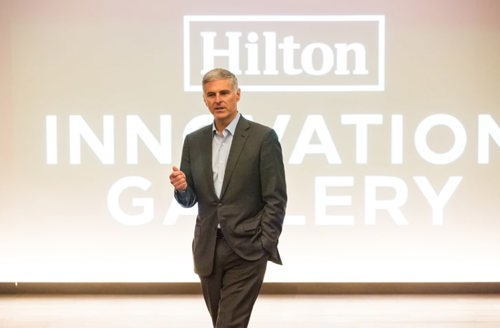In 1919, on his way to buy a bank in Texas, Conrad Hilton decided to purchase a hotel instead.
And so began the Hilton hotel empire.
Growing to become the first coast-to-coast hotel chain in the United States, and one of the first to spread internationally, Hilton hotels were often ahead of the industry. In 1927, it opened its first hotel with running water and air conditioning. It was the first in the world to install televisions in guestrooms (Roosevelt Hilton, New York City, 1947) and the first to have a central reservations system (1973).
In 1946, Hilton Hotels Corporation was the first hotel company to be listed on a stock exchange (NYSE:HLT).
By around 2006, Hilton had grown to the world’s fifth-largest hotel by number of rooms.
However, it was experiencing stagnation and corporate bloat.
Its performance had become mediocre. Growth had become sluggish for the global icon with an earlier reputation for glamour and innovation, and quality standards were poor, as were customer experiences.
Was Hilton now on a long, slow trajectory of decline?
Important: The information on this website is for experienced investors. It is not a personal recommendation to invest. If you’re unsure, please seek advice. Investments are for the long term. They are high risk and illiquid and can fall as well as rise in value: you could lose all the money you invest. This is an example of a particularly successful deal. You should expect some deals to fail or lose money.
An opportunity for private equity?
In July 2007, private equity giant Blackstone bought up Hilton Hotels Corporation for $26 billion. It was hailed at the time as one of the largest private equity deals ever executed.
Investing on behalf of some of the world’s largest institutional investors, from pension funds to endowments, Blackstone today has over $1 trillion of assets under management (AUM) – a scale that allows it to make such large acquisitions.
Blackstone structured the Hilton deal as a leveraged buyout (LBO): $20.5 billion was financed through debt (an arrangement of loans to the business) and $5.6 billion through equity (a purchase of shares in the business).
The aim was to enhance its value and exit at a profit within a target number of years.
Hilton’s now-legendary journey with Blackstone
Not long after Blackstone closed its £26 billion Hilton LBO, the 2008 financial crisis hit. Bear Stearns and Lehman Brothers – two loan providers in the deal – collapsed. Tourism went into a terrible slump. And Blackstone at one point had to write down the investment by 71%.
Blackstone’s then global head of real estate (and today its president and COO) Jonathan Gray was the architect of the deal. One of the first things he did when acquiring Hilton was to bring in a new CEO – Christopher Nassetta – to reorganise the business. Nassetta had previously headed the world's largest hotel ownership company, Host Hotels and Resorts.

Whilst Nassetta continued to work at restructuring and revitalising the business, Gray hurried to negotiate debt restructuring.
Doubling down on its investment, Blackstone managed to cut interest costs by buying back $2 billion of the debt for $800 million – a phenomenal discount – and converting a further $2 billion into Hilton preferred stock.
At the same time, Nassetta proved to be an astute choice. Under his tenure, the Hilton group has expanded into emerging markets and grown its footprint abroad and at home. Nassetta streamlined operations and spearheaded using technology to improve the guest experience – for instance, guests can book stays, check in, unlock their room door with a Digital Key and check out, all from an app on their smartphone. He has also brought a sea change to the corporate culture, and Hilton has been named World’s Best Workplace by Great Place to Work and Fortune magazine.
To capture more customers the company launched new brands across hospitality sectors. To create shareholder value, it spun off its real estate unit Park Hotels & Resorts and timeshare business Hilton Grand Vacations.
The business now has more than 1.2 million rooms – over twice as many as when Nassetta took over – across a portfolio of 24 world-class brands, comprising more than 8,000 properties in 126 countries and territories.
World No.1 hotel, and a multibillion profit exit
In 2024, Hilton Hotels & Resorts has been named the world’s most valuable hotel brand for the ninth year running, with an estimated brand value of $11.6 billion. Eight other Hilton brands have also made it into the Top 50 rankings, including Hampton Inn, DoubleTree, Conrad and Waldorf Astoria.
Blackstone returned Hilton to the public markets in December 2013, at a valuation $7 billion higher than when acquired. The $2.35 billion IPO made this the biggest ever share sale by a hotel company, and outstripped Twitter’s $1.8 billion IPO of around the same time.
Blackstone began winding down its investment in Hilton in June 2014 and sold its last remaining stake in the company in 2018.
In all, Blackstone realised a profit of some $14 billion, more than trebling its original investment in 11 years. A Bloomberg report at the time described it as “the most profitable private equity deal in history… badly timed but brilliantly executed.”
See share price five-year discrete performance
| 2022-23 | 2021-22 | 2020-21 | 2019-20 | 2018-19 | |
|---|---|---|---|---|---|
|
Hilton Worldwide Holdings Inc |
36.52% |
-8.21% |
42.26% |
-4.01% |
50.65% |
Source: Morningstar, 31/12/2018 to 31/12/2023, with dividends reinvested, in GBP. Past performance is not a guide to the future.
Wealth Club aims to make it easier for experienced investors to find information on – and apply for – investments. You should base your investment decision on the offer documents and ensure you have read and fully understand them before investing. The information on this webpage is a marketing communication. It is not advice or a personal or research recommendation to buy any of the investments mentioned, nor does it include any opinion as to the present or future value or price of these investments. It does not satisfy legal requirements promoting investment research independence and is thus not subject to prohibitions on dealing ahead of its dissemination.
